2010 PEUGEOT 308 SW BL ESP
[x] Cancel search: ESPPage 94 of 336
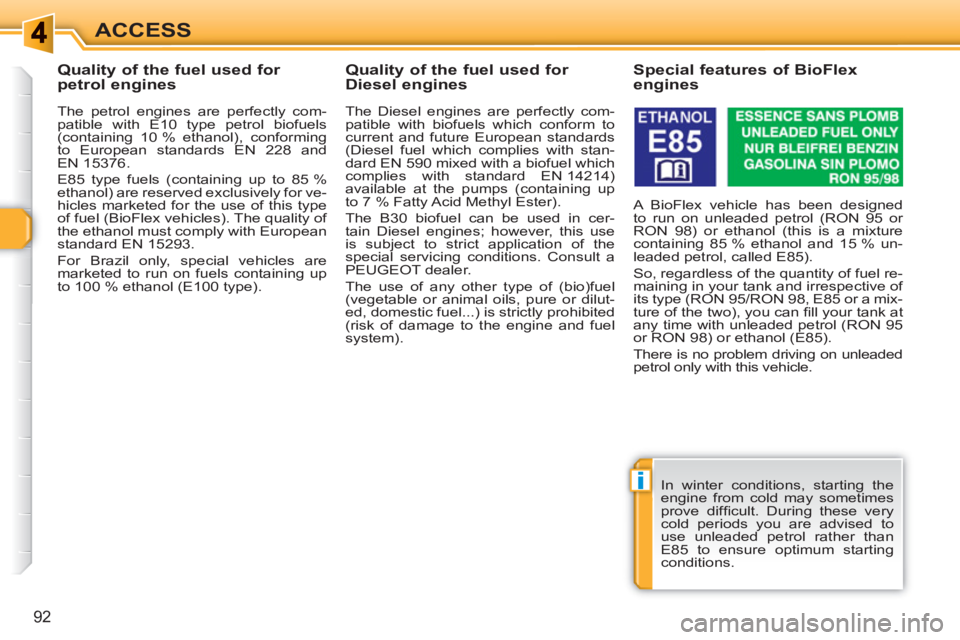
i
92
ACCESS
Quality of the fuel used for
petrol engines
The petrol engines are perfectly com-
patible with E10 type petrol biofuels
(containing 10 % ethanol), conforming
to European standards EN 228 and
EN 15376.
E85 type fuels (containing up to 85 %
ethanol) are reserved exclusively for ve-
hicles marketed for the use of this type
of fuel (BioFlex vehicles). The quality of
the ethanol must comply with European
standard EN 15293.
For Brazil only, special vehicles are
marketed to run on fuels containing up
to 100 % ethanol (E100 type).
Quality of the fuel used for
Diesel engines
The Diesel engines are perfectly com-
patible with biofuels which conform to
current and future European standards
(Diesel fuel which complies with stan-
dard EN 590 mixed with a biofuel which
complies with standard EN 14214)
available at the pumps (containing up
to 7 % Fatty Acid Methyl Ester).
The B30 biofuel can be used in cer-
tain Diesel engines; however, this use
is subject to strict application of the
special servicing conditions. Consult a
PEUGEOT dealer.
The use of any other type of (bio)fuel
(vegetable or animal oils, pure or dilut-
ed, domestic fuel...) is strictly prohibited
(risk of damage to the engine and fuel
system).
Special features of BioFlex
engines
A BioFlex vehicle has been designed
to run on unleaded petrol (RON 95 or
RON 98) or ethanol (this is a mixture
containing 85 % ethanol and 15 % un-
leaded petrol, called E85).
So, regardless of the quantity of fuel re-
maining in your tank and irrespective of
its type (RON 95/RON 98, E85 or a mix-
ture of the two), you can fi ll your tank at
any time with unleaded petrol (RON 95
or RON 98) or ethanol (E85).
There is no problem driving on unleaded
petrol only with this vehicle.
In winter conditions, starting the
engine from cold may sometimes
prove diffi cult. During these very
cold periods you are advised to
use unleaded petrol rather than
E85 to ensure optimum starting
conditions.
Page 95 of 336
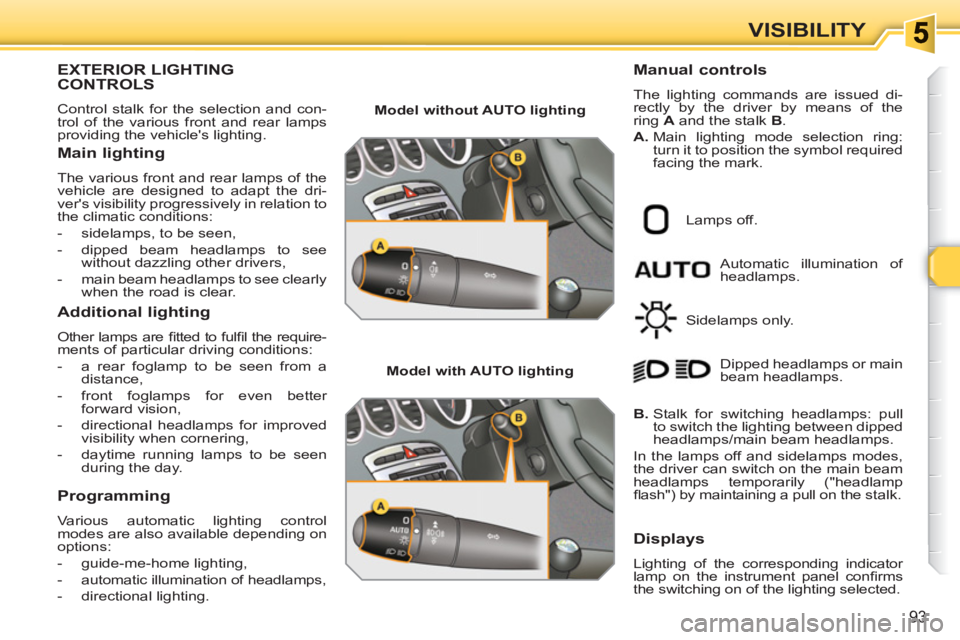
93
VISIBILITY
EXTERIOR LIGHTINGCONTROLS
Control stalk for the selection and con-
trol of the various front and rear lamps
providing the vehicle's lighting.
Main lighting
The various front and rear lamps of the
vehicle are designed to adapt the dri-
ver's visibility progressively in relation to
the climatic conditions:
- sidelamps, to be seen,
- dipped beam headlamps to see
without dazzling other drivers,
- main beam headlamps to see clearly
when the road is clear.
Additional lighting
Other lamps are fi tted to fulfi l the require-
ments of particular driving conditions:
- a rear foglamp to be seen from a
distance,
- front foglamps for even better
forward vision,
- directional headlamps for improved
visibility when cornering,
- daytime running lamps to be seen
during the day.
Programming
Various automatic lighting control
modes are also available depending on
options:
- guide-me-home lighting,
- automatic illumination of headlamps,
- directional lighting.
Model without AUTO lighting
Model with AUTO lighting
Automatic illumination of
headlamps.
Manual controls
The lighting commands are issued di-
rectly by the driver by means of the
ring A
and the stalk B
.
A.
Main lighting mode selection ring:
turn it to position the symbol required
facing the mark.
Lamps off.
Sidelamps only.
B.
Stalk for switching headlamps: pull
to switch the lighting between dipped
headlamps/main beam headlamps.
In the lamps off and sidelamps modes,
the driver can switch on the main beam
headlamps temporarily ("headlamp
fl ash") by maintaining a pull on the stalk. Dipped headlamps or main
beam headlamps.
Displays
Lighting of the corresponding indicator
lamp on the instrument panel confi rms
the switching on of the lighting selected.
Page 96 of 336

!
i
94
VISIBILITY
Model with rear foglamp only
Rear foglamp
�)
To switch on the foglamp, turn the
ring C
forwards.
When the lighting is switched off au-
tomatically (with AUTO model), the fo-
glamp and the dipped beam headlamps
will remain on.
�)
To switch off all of the lighting, turn
the ring C
rearwards.
In good or rainy weather, both day
and night, the front foglamps and
the rear foglamp are prohibited. In
these situations, the power of their
beams may dazzle other drivers.
They should only be used in fog or
snow.
In these weather conditions, it is
your responsibility to switch on the
foglamps and dipped beam head-
lamps manually as the brightness
sensor may detect suffi cient light.
Do not forget to switch off the front
foglamps and the rear foglamp when
they are no longer necessary.
Switching off of the lamps when
the ignition is switched off
On switching off the ignition, all of
the lamps turn off immediately, ex-
cept for dipped beam if guide-me-
home lighting is activated.
Model with front foglamps and
a rear foglamp
Front and rear foglamps
Rotate and release the ring C
:
�)
forwards a fi rst time to switch on the
front foglamps.
�)
forwards a second time to switch on
the rear foglamp,
�)
rearwards a fi rst time to switch off
the rear foglamp
�)
rearwards a second time to switch
of the front fog lamps.
When the lighting is switched off auto-
matically (with AUTO model) or when
the dipped headlamps are switched off
manually, the foglamps and sidelamps
will remain on.
�)
Turn the ring rearwards to switch
off the foglamps, the sidelamps will
then switch off.
C.
Foglamp selection ring.
The foglamps operate with the dipped
and main beam headlamps.
Switching on the lamps after
the ignition is switched off
To reactivate the lighting control, ro-
tate ring A
to the "0"
position - lamps
off, then to the desired position.
On opening the driver's door a
temporary audible signal warns the
driver that the lighting is on.
The lamps, with the exception of the
sidelamps, switch off automatically
after a maximum duration of thir-
ty minutes to prevent discharging of
the battery.
Page 103 of 336
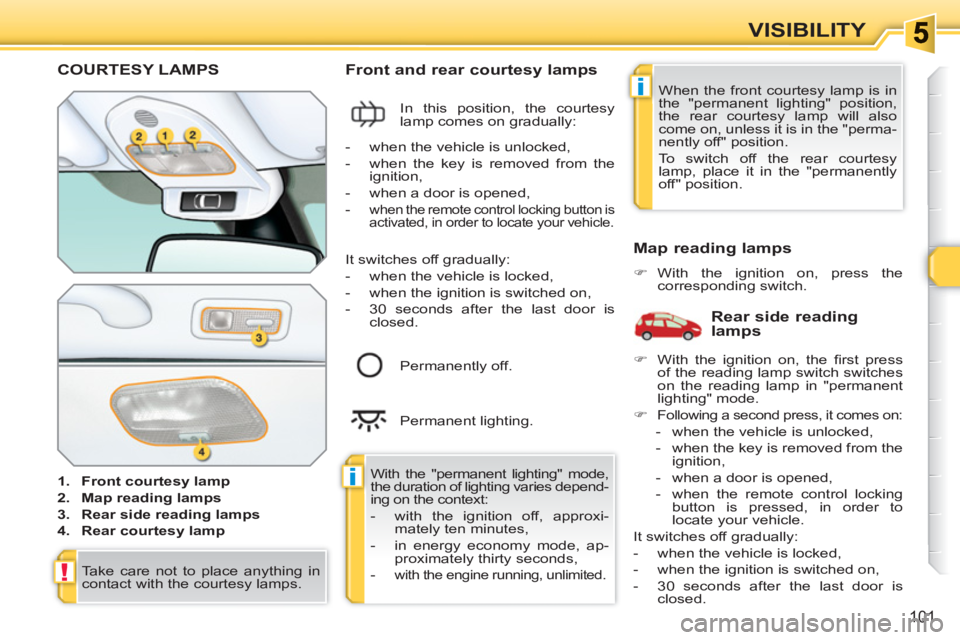
i
i
!
101
VISIBILITY
COURTESY LAMPS
1.
Front courtesy lamp
2.
Map reading lamps
3.
Rear side reading lamps
4.
Rear courtesy lamp
Front and rear courtesy lamps
In this position, the courtesy
lamp comes on gradually:
Map reading lamps
�)
With the ignition on, press the
corresponding switch.
With the "permanent lighting" mode,
the duration of lighting varies depend-
ing on the context:
- with the ignition off, approxi-
mately ten minutes,
- in energy economy mode, ap-
proximately thirty seconds,
-
with the engine running, unli mited.
- when the vehicle is unlocked,
- when the key is removed from the
ignition,
- when a door is opened,
-
when the remote control locking button is
activated, in order to locate your vehicle.
Permanently off.
Permanent lighting.
When the front courtesy lamp is in
the "permanent lighting" position,
the rear courtesy lamp will also
come on, unless it is in the "perma-
nently off" position.
To switch off the rear courtesy
lamp, place it in the "permanently
off" position.
Rear side reading
lamps
It switches off gradually:
- when the vehicle is locked,
- when the ignition is switched on,
- 30 seconds after the last door is
closed.
Take care not to place anything in
contact with the courtesy lamps.
�)
With the ignition on, the fi rst press
of the reading lamp switch switches
on the reading lamp in "permanent
lighting" mode.
�)
Following a second press, it comes on:
- when the vehicle is unlocked,
- when the key is removed from the
ignition,
- when a door is opened,
- when the remote control locking
button is pressed, in order to
locate your vehicle.
It switches off gradually:
- when the vehicle is locked,
- when the ignition is switched on,
- 30 seconds after the last door is
closed.
Page 115 of 336
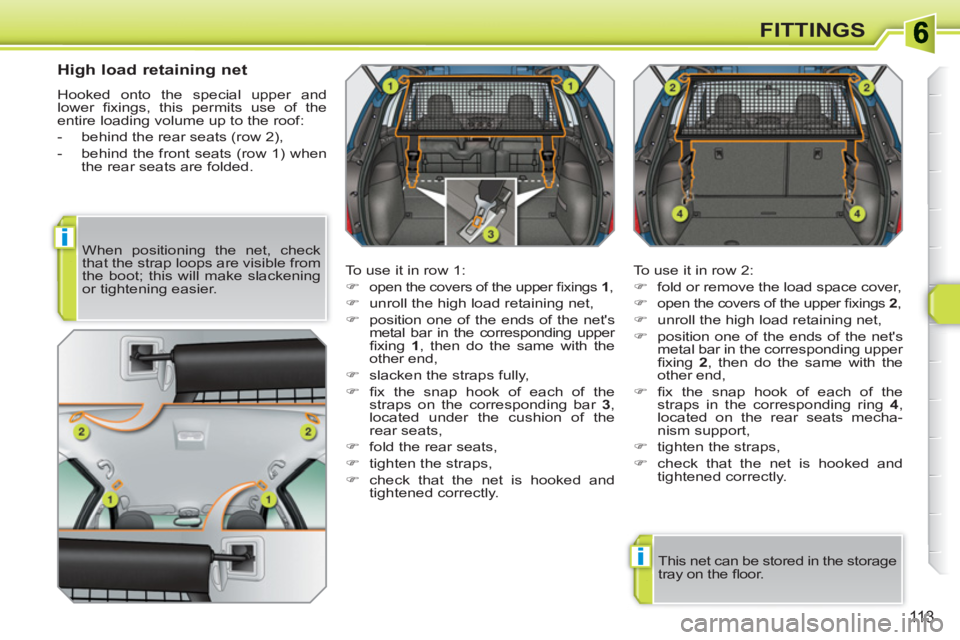
i
i
113
FITTINGS
High load retaining net
Hooked onto the special upper and
lower fi xings, this permits use of the
entire loading volume up to the roof:
- behind the rear seats (row 2),
- behind the front seats (row 1) when
the rear seats are folded.
To use it in row 1:
�)
open the covers of the upper fi xings 1
,
�)
unroll the high load retaining net,
�)
position one of the ends of the net's
metal bar in the corresponding upper
fi xing 1
, then do the same with the
other end,
�)
slacken the straps fully,
�)
fi x the snap hook of each of the
straps on the corresponding bar 3
,
located under the cushion of the
rear seats,
�)
fold the rear seats,
�)
tighten the straps,
�)
check that the net is hooked and
tightened correctly. To use it in row 2:
�)
fold or remove the load space cover,
�)
open the covers of the upper fi xings 2
,
�)
unroll the high load retaining net,
�)
position one of the ends of the net's
metal bar in the corresponding upper
fi xing 2
, then do the same with the
other end,
�)
fi x the snap hook of each of the
straps in the corresponding ring 4
,
located on the rear seats mecha-
nism support,
�)
tighten the straps,
�)
check that the net is hooked and
tightened correctly. When positioning the net, check
that the strap loops are visible from
the boot; this will make slackening
or tightening easier.
This net can be stored in the storage
tray on the fl oor.
Page 118 of 336
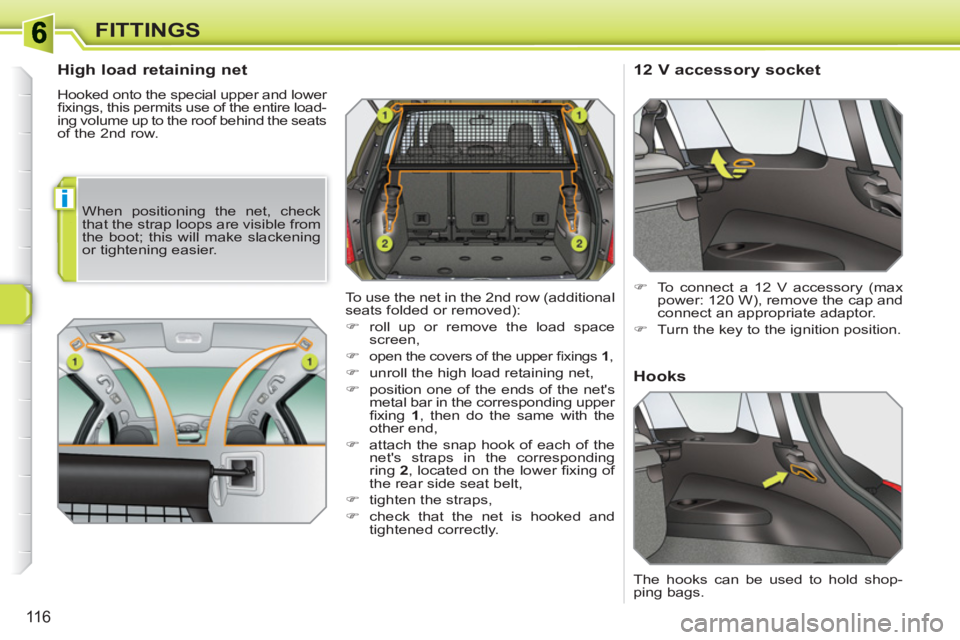
i
116
FITTINGS
High load retaining net
Hooked onto the special upper and lower
fi xings, this permits use of the entire load-
ing volume up to the roof behind the seats
of the 2nd row.
12 V accessory socket
�)
To connect a 12 V accessory (max
power: 120 W), remove the cap and
connect an appropriate adaptor.
�)
Turn the key to the ignition position.
To use the net in the 2nd row (additional
seats folded or removed):
�)
roll up or remove the load space
screen,
�)
open the covers of the upper fi xings 1
,
�)
unroll the high load retaining net,
�)
position one of the ends of the net's
metal bar in the corresponding upper
fi xing 1
, then do the same with the
other end,
�)
attach the snap hook of each of the
net's straps in the corresponding
ring 2
, located on the lower fi xing of
the rear side seat belt,
�)
tighten the straps,
�)
check that the net is hooked and
tightened correctly.
Hooks
When positioning the net, check
that the strap loops are visible from
the boot; this will make slackening
or tightening easier.
The hooks can be used to hold shop-
ping bags.
Page 119 of 336

!i
11 7
FITTINGS
Torch
This is a removable lamp, fi tted in the
boot wall, which can be used to light the
boot or as a torch.
For the boot lamp function, refer to the
"Visibility - § Boot lamp" section.
Operation
This torch operates with NiMH type re-
chargeable bateries.
It has an battery life of approximately
45 minutes and charges while you are
driving.
Use
�)
Extract the torch from its location
pulling it upwards.
�)
Press the switch, located on the
back, to switch the torch on or off.
�)
Unfold the support, located on the
back, to set down and raise the
torch; for example, when changing
a wheel.
Storing
�)
Put the torch back in place in its
location starting with the lower part.
If you have forgotten to switch
off the torch, this switches it off
automatically.
Side blinds
Fitted on the rear windows of the
2nd row, these protect your young chil-
dren from the sun.
�)
Pull the blind by the central tab.
�)
Position the blind attachments on
the corresponding hooks.
Observe the polarities when fi tting
the rechargeable batteries.
Never replace the rechargeable
batteries with normal batteries. It the torch is not engaged correctly, it
may not charge and may not come
on when the boot is opened.
Page 131 of 336

!
i
i
i
129
SAFETY
TYRE UNDER-INFLATIONDETECTION
System which automatically and contin-
uously checks the pressure of the tyres
while driving. All repairs and changing of tyres on
a wheel fi tted with this system must
be carried out by a PEUGEOT
dealer.
If, when changing a tyre, you in-
stall a wheel which is not detected
by your vehicle (example: fi tting
of snow tyres), you must have the
system reinitialised by a PEUGEOT
dealer.
This system does not avoid the
need to have the tyre pressures
checked regularly (refer to the
"Identifi cation markings" section) to
ensure that the optimum dynamic
performance of the vehicle is main-
tained and prevent premature wear
of the tyres, particularly in arduous
driving conditions (heavy load, high
speed).
The tyre pressures must be checked cold, at least once a month.
Remember to check the pressure
of the spare wheel.
The tyre under-infl ation detection
system may experience temporary
interference due to electro-magnetic
emissions on a frequency close to
that used by the system.
Sensors fi tted in each valve trigger a
warning in the event of problem (speed
above 12 mph (20 km/h)).
This warning lamp is displayed on the
instrument panel and/or a message
appears on the multifunction screen,
accompanied by an audible signal,
to locate the wheel concerned.
�)
Check the tyre pressures as soon
as possible.
This check must be carried out when the
tyres are cold.
Under-infl ated tyre
The STOP
warning lamp comes
on and/or this warning lamp
is displayed on the instrument
panel, accompanied by an au-
dible signal and a message on
the multifunction screen locat-
ing the wheel concerned.
�)
Stop as soon as it is safe to do so,
avoiding any sudden movement of
the steering wheel and the brakes.
�)
Repair or change the damaged
wheel (punctured or very defl ated
tyre), and have the tyre pressure
checked as soon as possible.
Puncture
The tyre under-infl ation detection
system is an aid to driving which does
not replace the need for the driver to
be vigilant or to drive responsibly.
Sensor(s) not detected or faulty
This warning lamp is displayed
on the instrument panel and/or
a message appears on the mul-
tifunction screen, accompanied
by an audible signal, to locate the wheel
or wheels which are not detected or to
indicate a fault in the system.
Contact a PEUGEOT dealer to replace
the faulty sensor(s).
This message is also displayed
when one of the wheels is away
from the vehicle (being repaired) or
when one or more wheels without a
sensor are fi tted.
If your vehicle is equipped with a
spare wheel, this is not fi tted with
a sensor.